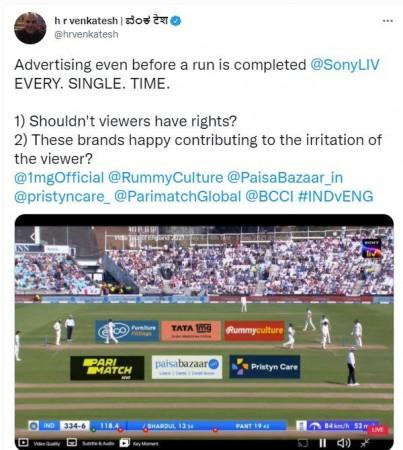What are the chances a hard-core cricket fan is going to buy the toothpaste that they just tried selling in the middle of the pitch? Even before a run is completed?

There is a difference between grabbing eyeballs and pushing a product down consumers' throat (in this case, eyes). And then there's hampering a cricket fan's viewing experience and irritating the potential customers. Which is exactly what has been happening, especially during the India Tour of England 2021 test matches aired on SonyLiv.
Twitter user H R Venkatesh echoed the sentiments of millions of viewers in the post, "Advertising even before a run is completed? Every. Single. Time." Tagging the broadcast channel Sony Liv, he further questioned, "Shouldn't viewers have rights? These brands happy contributing to the irritation of the viewer?"
Furthermore, the advertisements in question are inserted using AR Tech. The brands are not actually there on the ground, but only virtually on the pitch. And it goes without saying that it hurts all the more when the viewer is paying a hefty price for the subscription as well.

When cricket weds advertising
Given India's love for cricket and the massive reach the sport has, advertising on cricket grounds has been a proven way to reach the potential customers and increase the sales. But of late, the platform has come in for misuse rather than optimum use.
Who hasn't felt frustrated at the suddenly shrunk size of the screen to send out a commercial message, the moment the game gets exciting? Why are the commercials so loud and jingles so noisy that one needs to reach for the mute button on remote, during any ad break? What another ad break? Didn't you just see one?
Finally, TRAI wakes up
Acknowledging the crossed line by advertising and corporates, Telecom Regularity Authority of India (TRAI) in 2012 proposed a few regulations in a paper titled, "Issues Related to Advertisements on TV Channels."
Among the seven proposed stipulations, a few concerned sporting events as well. "In case of sporting events being telecast live, the advertisements shall only be carried during the interruptions in the sporting action e.g, half time in football or hockey match, lunch/drinks break in cricket matches, game/set change in case of tennis etc."
TRAI also said that there shall be only full screen advertisements. Part screen advertisements will not be permitted. Drop down advertisements will also not be permitted. Addressing the audio issues with the ads, it also said, "The audio level of the advertisements shall not be higher than the audio level of the programme."
In 2017, once again the broadcasting watchdog laid down a few rules just during the final lap of marketing haven IPL. It once again came heavily on drop down advertisements, the duration of ads and when they could be aired.
No, they are not painted!
Unlike in the 90s when cola companies bombarded the greens with pre-painted ads, now there are no pre-painted ads on the cricket grass and instead, the ad logos are projected onto the field by using it as a green screen.
What views say?
The novelty at severely hampering viewers' experience doesn't stay restricted to just the pitch. What started as a mild form of marketing with brand logos on the players' uniforms, has extended to every imaginable object in the stadium.
"This is so disturbing to the eyes, it sometimes remains superimposed on the bowler! And the app is so despicable for consumers too," wrote a user. Where are the insightful marketing studies? So, not in sync with customer sentiment?
Wrote another, "I think I am one of those who never used these brands and won't even use in future." There is no denying the risk of driving clients to the other side of the fence.










